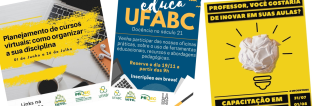Provision of MOOCs in the EMBRACE project: UFABC team tutors’ perspective on MOOC 1.
Published 24 February 2025

Photo by: UFABC Team
The EMBRACE project MOOCs involved UFABC teacher tutors who evaluated and improved content to ensure academic quality. They praised the variety of materials and digital tools but noted challenges in language integration, assessments, and Moodle navigation. Their feedback will help refine future editions.
The three MOOCs developed in the EMBRACE project involved the participation of UFABC lecturers invited to act as tutors. Their role includes improving the courses based on their expertise, high-level technical and scientific knowledge, evaluating and reviewing the content, ensuring that academic rigour is maintained in all the MOOC modules. The tutors were invited because of their motivation for innovation in teaching and co-creation processes, with the ability and interest to guide other colleagues on pedagogical issues, especially related to the integration of technologies in education and/or collaboration with the world of work. This process is facilitated by the IDs in line with the project’s staggered strategy, whereby 5 IDs and 2 experts are trained, and 15 teacher tutors are involved, who will be able to multiply the knowledge acquired in order to guarantee the sustainability of the project’s actions.
UFABC Teacher Tutors’ perspective on MOOC1 – Digital and Pedagogical Competences (DigiPeda)
The guest teacher tutors, guided by the IDs, carried out the three MOOC courses and presented their reflections on their experiences, providing feedback to improve the courses. The exchange of ideas resulted in adjustments to both the content and the form of presentation, preparing the MOOC to be launched on a larger scale to the entire university community and external audiences, with the aim of reaching around 300 teachers from all the EMBRACE project’s partner institutions. The focus of this phase is to ensure the project’s scalability and sustainability, with the creation of a support and monitoring structure to maintain and update the courses and the application of the Open Badges, which certify the competences acquired.
The first team of tutors included professors Aline Panazio, Cristiane Sato, Denise Goya, Giselle Watanabe, Luciana Milena, Paula Tiba and Renata Simões, and professors César Freire, Julio Carlos Teixeira and Leonardo Melo, who carried out MOOC 1 and shared detailed observations on the structure and content offered, highlighting both the strengths and areas to be improved for future editions.
Variety of materials and pedagogical integration of technologies.
Among the positive aspects, the variety of materials (videos and text) and interactive activities was widely praised. The way of accessing different types of content provided a dynamic and accessible learning experience. One of the tutors pointed out that ‘by alternating between short videos, texts and interactive activities, the course is very attractive and easy to follow’. They also highlighted the appropriate use of digital resources and innovative methodologies, such as the use of open licences and tools like H5P and Kahoot. The tutors recognised that these tools, when pedagogically well planned, can bring interesting possibilities for assessment and teaching.
Limitations and challenges
With regard to points for improvement, one of the challenges mentioned by the tutors was the issue of using different languages throughout the course. There was an effort to include subtitles, but the tutors pointed out that ‘the text of the subtitles is not always synchronised with the audio’, especially in the Spanish videos. One suggestion to mitigate the problem was to merge content in Portuguese and Spanish, rather than an abrupt split between the two languages, which caused fatigue at times. Regarding the questionnaires, tutors reported that some of the assessment questions were ‘very easy to answer, even without reading the material beforehand’, which led to an assessment process that did not challenge in-depth learning. Improvements were suggested in the design of the questions to avoid obvious answers or sarcastic alternatives, as well as avoiding the use of double negation, which confused the course participants. The course navigation interface on Moodle was another point of attention. Some tutors mentioned that they found it difficult to navigate between activities, especially when links led to external tools and/or forums or quizzes.
The suggestion was to create a video tutorial on navigating Moodle at the start of the course, to better orientate the participants. There was also concern about the local contextualisation of the content, especially in legal aspects and educational platform resources. For example, in topics such as ‘legal aspects’, it was noted that the examples only dealt with Colombia, without reference to the Brazilian context. In addition, tutors pointed out that platforms such as Moodle, presented in class, had different configurations to those used by Brazilian institutions, which made it difficult to apply the content studied in practice. In terms of interaction between participants, tutors suggested including debates or discussion panels using tools such as Padlet or Google Meet to promote greater engagement and exchange of experiences. One tutor mentioned that ‘the discussion forums didn’t work very well, and there was no effective interaction between the participants’, suggesting the implementation of short virtual meetings.
The tutors‘ feedback reinforces the relevance of the WP2 – teachers’ digital and pedagogical competence work package as an innovative training tool for teachers in Brazil and Colombia, but also points to important areas for improvement, especially in adapting the materials to local realities, improving the assessments and offering more intuitive and inclusive navigation. These contributions will be essential for revising MOOC 1 and for developing development of new, more interactive and accessible editions, and reveal the ongoing quest for excellence in higher education teacher training.



